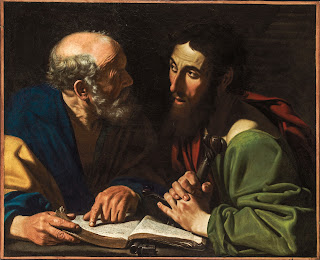Each miracle performed by Jesus was done to not only show His power over natural law, but to teach His disciples. These miracles were recorded in the Bible so they could also teach us, nearly two thousand years later. In this way each miracle story is unique and very important in helping us to understand Jesus, who He is, and what He was trying to teach the disciples, and indeed us. While every miracle is certainly important, can we pick just one? Perhaps the gospel writers did this for us.
Of the thirty-seven miracles recorded in the gospels, nineteen of them are only listed in one of the four gospels. Seven miracles are recorded in two of the gospel accounts, while another ten are recorded in three of the gospels. Only one however, is recorded in all four of the gospels. This miracle is the story of Jesus feeding the five thousand men.
As mentioned, this story is unique in that it is the only one of the thirty-seven miracles performed by Jesus that is recorded in all four Gospels. Is this just an odd fact, or does it signify this miracle has special significance and should therefore receive special attention? I find it hard to believe that anything in the Bible happens by chance or without a higher purpose.
Whatever the case, there are several messages which can be gleaned from this story. The first is to note that Jesus had gained a very large following. On this day five thousand men had left their homes, jobs and responsibilities to come out and listen to the teachings of Jesus. Given human nature, a great many of these people were probably there in hopes of witnessing one of the miracles Jesus was so well known for. Jesus would not disappoint.
Denarius – This was a Roman coin, made of silver, which was used extensively throughout the Roman empire. It first came into use in 211 B.C. and remained in use up until approximately 244 A.D.
Jesus sees the large crown and turns to Phillip and asked how they are to feed these people. Phillip gives a very practical answer saying that even two hundred denarii would not be enough to feed this multitude. In that day, a denarius would have been equivalent to a day’s wages. Not even two hundred days wages could have bought enough food. Jesus knew this, but he wanted to show the disciples that he had no need of money to fulfill the needs of His followers.
John wrote his gospel in Greek and the term he used for the crowd of people is gender specific (men). This would mean he had only included the men and not the women and children. While there is no way to be certain, it is certainly possible the crowd was as large as fifteen thousand people.
Andrew, Peter’s brother, then tells Jesus that they have five loaves of bread and two fish. Andrew did not see this as an answer but was more likely mentioning these to show just how desperate their situation was. Jesus did not see this as a detriment, but as an opportunity. Jesus was about to show His disciples, as well as His followers, that He could supply their needs with very little.
Jesus took the fish and bread from the youth. When it was all distributed the crowd ate all they wanted and there was excess. Jesus here shows we should not waste, even when we have an excess and even when we did not pay for the items. Jesus ordered the leftovers to be gathered “that nothing be lost”. In all they gathered up twelve baskets of leftover bread when they started with just five loaves.
Jesus used someone and their resources that everyone else overlooked and thought of as insignificant. The boy, who goes unnamed, had very little, but we must assume he surrendered it to Jesus when asked. It seemed like very little, but was more than enough in the hands of Jesus. What do we have that can become something special in the hands of Jesus?
There is a potential significance that the number of baskets was twelve. Some believe the twelve baskets of bread is a direct reference to the twelve tribes of Israel. – In the time of Moses God feed the twelve tribes of Israel with manna from heaven. Here Jesus feeds the multitude of followers with bread multiplied from five loaves.
The people, when they saw what had happened, began to call Jesus a prophet. It is highly probable they were making a reference to scripture and a statement made by Moses in Deuteronomy 18:15.
“Yahweh your God will raise up to you a prophet from among you, of your brothers, like me. You shall listen to him.” – Deut 18:15
In the next verse Jesus sees that the people are ready to take Him away and crown Him king. This was certainly not His plan and He withdrew to the mountains to be alone.
Archaeological Discovery – A church was erected at the location where the miracle of the loaves and fishes is believed to have taken place. The church is known as the “Church of the Multiplication”. The first church known to be built here was constructed in 350 A.D. – The church was significantly expanded in 480 A.D. The enlargement included the addition of mosaic floors showing a basket of loaves and two fish. The church was mostly destroyed in 614 A.D. and the site of the church was then lost until 1888. Full excavations took place in 1932 and a new church was inaugurated in 1984.
This miracle is special in a number of ways. It shows Jesus is ready willing and able to supply the needs of His followers. These needs include not only their spiritual needs, but their earthly day-to-day needs as well. He can not only meet these needs but meets them in abundance. It also shows a possible direct reference to an Old Testament scripture and teaches us to not be wasteful with the gifts and blessings supplied by Jesus. There is a great deal to be learned by all of us from this miracle, but is it the greatest miracle Jesus Performed.
Can the feeding of five thousand, or even the potentially fifteen thousand, compare to raising someone from the dead? Restoring a blind man's sight, or casting out a demon? A case can be made for any of these miracles, but the feeding of the five thousand is in a unique setting. Jesus is meeting the everyday needs of His followers, He is feeding them. Throughout the gospel Jesus has meals with His disciples and with His followers. The breaking of bread is very significant and, in this case, Jesus shows He can use very little to help a great many. Is he also perhaps showing just how much we can do for others, even though we believe we may have very little to offer? With the help of Jesus, what we have, as little as it might be, can be multiplied and become far more significant. When combined, all of the various messages and teaching of this miracle make it very important, and very relatable to many. In its simple message of providing for others, Jesus performs one of His greatest miracles.
________________________________________________________
Post is taken in large part from the book "New Testament Miracles" which is available from Amazon in eBook, paperback or hardcover.


















